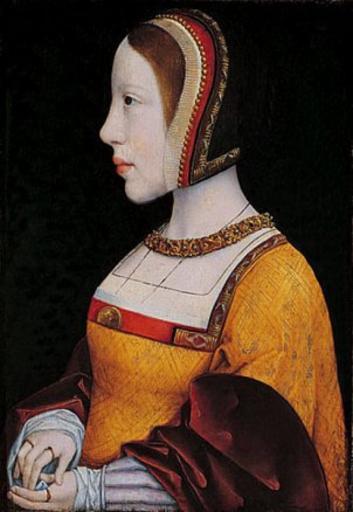MAKE A MEME
View Large Image

| View Original: | Isabella,_Queen_of_Denmark,_Niece_of_Catherine_of_Aragon.jpg (302x438) | |||
| Download: | Original | Medium | Small | Thumb |
| Courtesy of: | www.flickr.com | More Like This | ||
| Keywords: catherine of aragon catherineofaragon european royalty europeanroyalty portrait indoor On 11 July 1514 Isabella was married by proxy to King Christian II of Denmark with Emperor Maximilian, her grandfather, standing in for the king. A year later, the Archbishop of Norway was sent to escort her to Copenhagen. The marriage was ratified on 12 August 1515. Isabella was crowned Queen of Denmark and given the name Elisabeth, but the relationship between her family and king Christian was quite cool during the first year of the marriage. The King's Dutch mistress, Dyveke Sigbritsdatter, had been with him since 1507, and he was not about to give her up for a teenaged girl. This angered the Emperor, and caused some diplomatic strife between him and King Christian, but the matter was resolved when Dyveke died in 1517, and Isabella's relationship with her husband improved vastly over the next few years. She bore him three children, Hans, Christina and Dorothea, and when king Christian was deposed in 1523 by disloyal noblemen supporting his aging uncle duke Frederick, the new king wanted to be on good terms with her family. He wrote her a personal letter in her native German, offering her a dowager queen's pension and permitting her to stay in Denmark under his protection while king Christian fled to the Netherlands. But Isabella wrote back to duke Frederick in Latin, stating that "ubi rex meus, ibi regna mea", that is "where my king is, there is my kingdom". She then left Denmark with her husband and their children. The young queen died at Ghent at just twenty-four years of age. Isabella's most famous daughter was the Christina, Duchess of Milan made famous in Holbein's portrait, painted when Henry VIII of England was looking for his fourth wife. Her other daughter, Dorothea of Denmark, married Frederick II, Elector Palatine. It is said that the daughter of Denmark's Crown Prince Frederik and Crown Princess Mary, Princess Isabella, was named after her. On 11 July 1514 Isabella was married by proxy to King Christian II of Denmark with Emperor Maximilian, her grandfather, standing in for the king. A year later, the Archbishop of Norway was sent to escort her to Copenhagen. The marriage was ratified on 12 August 1515. Isabella was crowned Queen of Denmark and given the name Elisabeth, but the relationship between her family and king Christian was quite cool during the first year of the marriage. The King's Dutch mistress, Dyveke Sigbritsdatter, had been with him since 1507, and he was not about to give her up for a teenaged girl. This angered the Emperor, and caused some diplomatic strife between him and King Christian, but the matter was resolved when Dyveke died in 1517, and Isabella's relationship with her husband improved vastly over the next few years. She bore him three children, Hans, Christina and Dorothea, and when king Christian was deposed in 1523 by disloyal noblemen supporting his aging uncle duke Frederick, the new king wanted to be on good terms with her family. He wrote her a personal letter in her native German, offering her a dowager queen's pension and permitting her to stay in Denmark under his protection while king Christian fled to the Netherlands. But Isabella wrote back to duke Frederick in Latin, stating that "ubi rex meus, ibi regna mea", that is "where my king is, there is my kingdom". She then left Denmark with her husband and their children. The young queen died at Ghent at just twenty-four years of age. Isabella's most famous daughter was the Christina, Duchess of Milan made famous in Holbein's portrait, painted when Henry VIII of England was looking for his fourth wife. Her other daughter, Dorothea of Denmark, married Frederick II, Elector Palatine. It is said that the daughter of Denmark's Crown Prince Frederik and Crown Princess Mary, Princess Isabella, was named after her. | ||||